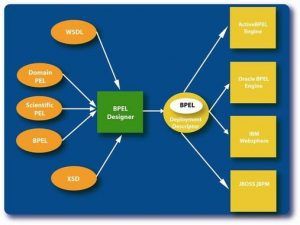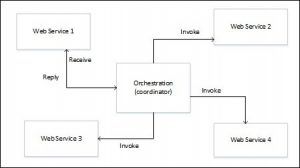In any given business, there are processes which need to be repeated. Although there may be a small number of business processes that don’t use computer logic or web services, the reality is that most modern business practices take place virtually.
So how do business leaders ensure that processes are defined and followed? Enter stage: BPEL.
Developed and approved by OASIS (a technical committee containing business and technology giants such as Dell, IBM, and Microsoft), BPEL is designed to provide businesses with a way to automate and orchestrate business processes—sending emails, completing transactions, processing data, and many other different procedures, including the ability to correct errors found in other processes.
So, let’s take a look.
What is BPEL?
The name says it all: business process execution language.
BPEL is a language that makes these business processes programmable and easy to implement. Being able to define your processes, orchestrate and choreograph processes, and integrate web services into the average business workflow makes integrating BPEL a jump forward for teams aiming to improve the automated aspect of their organization.
The birth of BPEL
Developed in 2001 by IBM and Microsoft, Business Process Execution Language was designed to combine two now defunct XML languages: IBM’s WSFL and Microsoft’s Xlang. These languages were used for programming in the large and served similar purposes in the business context.
Although Microsoft initially intended to carry out this process on their own with the development of XLANG/s, the two companies joined forces to create an XML language which would take the market by storm.
Business Process Execution Language version 1.0/1.1
The two companies developed and named the resulting programming language “BPEL4WS”—short for Business Process Execution Language for Web Services. This name would be later abandoned, but the initial BPEL4WS was a big step in the direction of creating a programming in the large language that would dominate the market.
Business Process Execution Language 2.0
Throughout the years, additional teams have contributed to the Business Process Execution Language project, including SAP and Adobe Systems.
The most recent version of BPEL (WS-BPEL 2.0) was released in 2007. SAP would go on to create the Business Process Execution Language for People (BPEL4People) to explain the benefits BPEL and web services can be combined with human interactions.
Components of BPEL
The ease of integrating BPEL within your organization allows for enterprise-scale automation of services, including external process through Web services.
When originally designed, the team behind BPEL intend to fulfill 10 design goals:
- Define business processes through web services to help them interact with external entities
- Use an XML-based language to fulfill all business needs
- Build web services orchestration capabilities into the language as abstract and executable business processes
- Regimes that are both hierarchal and graph-like to reduce fragmentation
- Data manipulation and analysis functionality is built into the language
- Supports an identification mechanism
- Creation and termination of processes in the basic lifecycle mechanism
- Define a transaction model that includes techniques such as compensation actions and scoping
- Web services is the underlying model
- All functionality builds on and adds to the web services standard

BPEL example workflow (Source)
Because of these 10 aims, BPEL (particularly the 2.0 version) was designed to be an orchestration language—not a choreography language like Xlang and the initial BPEL4WS creation.
The additional benefits that BPEL brings to a company through these 10 aims include:
- Large scale automation
- Orchestration of automated processes
- Easy to integrate web services
(Compare automation & orchestration.)
BPEL and orchestration
BPEL orchestrates processes, resulting in three distinct benefits for businesses:
- Data and services are easier to access
- The business becomes more agile
- Inexpensive to integrate new services is inexpensive
When your organization can access many internal and external services, BPEL can take all the data and make it readily available to you from a centralized location.
Using external web services actually adds to the overall automation process—web services handle both abstract business and executable business processes, allowing your staff to spend more human hours on what you need them to.
Similarly, new aspects of the infrastructure can be immediately integrated with BPEL and web services, allowing large scale improvements to business process.
Whenever new applications or infrastructure is added, they can be immediately integrated with new process descriptions. Large scale changes cause problems for many organizations, but the BPEL process management is there to make the process as painless as possible.

Orchestration in action (Source)
BPEL use cases
Suggested use cases for WS-BPEL/Business Process Execution Language of other versions can be found on the OASIS Open website.
BPEL & Salesforce
When Salesforce needs to interact with the head CRM application, BPEL can be used to automatically communicate between the BPEL powered execution environment (or the engine and the platform) and allow for proper application integration.
BPEL & data manipulation
BPEL is perfect for data collection and manipulation. The use case provided by OASIS allows for a number of functions, including:
- Variable initialization
- Assigning variables by copying another variable or other variables
- Creating and working with sample XPath calculations
- Working with array structures
Integrating BPEL in your organization
Businesses live and die on their ability to repeat mission critical tasks. When these tasks can become more agile and performed without expensive integrations, a business can look forward to developing their process.
When you can take every business process in your organization and make it automatic, there are increases for business efficiency (even in the face of human behavior, thanks to SAP’s work with BPEL4People).
Integrating BPEL is perfect for businesses that have a wide range of process descriptions that can make the leap to the world of automation. With BPEL, business process management is straightforward.
Related reading
- BMC Workload Automation Blog
- BMC Business of IT Blog
- What are Service Orchestration and Automation Platforms (SOAPs)?
- Top Programming Languages To Learn Today
- DataOps Explained: Understand how DataOps leverages analytics to drive actionable business insights
- What Is ITBM? IT Business Management Explained







